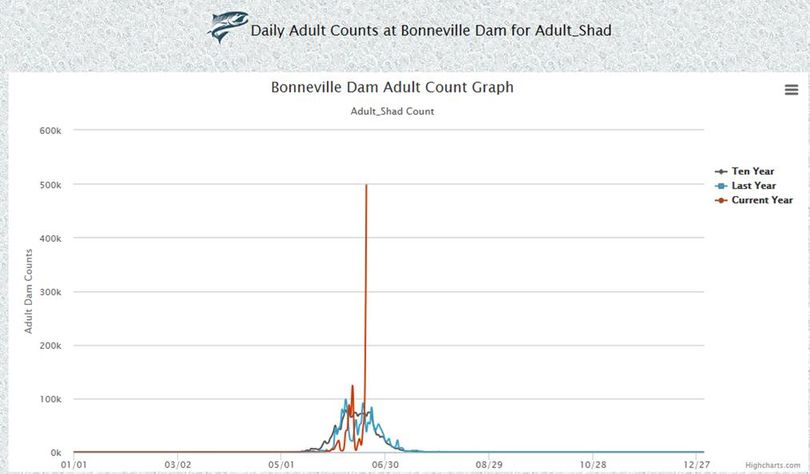Columbia River shad run explodes in near-record burst over Bonneville Dam

FISHING -- Holy shad! Fish managers couldn't believe their eyes when they scanned the fish count numbers from Bonneville Dam this morning.
"I had to call the COE fish count hotline message to confirm 497,738 shad were counted at Bonneville Dam yesterday," said Joe Hymer, Washington Department of Fish and Wildlife salmon specialist in Vancouver. "It confirmed the count."
The June 19, 2017, count was the third-largest largest on record since at least 1946, he said. "The highest daily counts were June 5 and 6, 2003, when 504,724 and 520,664 fish were tallied, respectively.
"More shad were counted Monday in a single day than the total annual counts in all but three years from 1946-1977."
The total shad run over Bonneville Dam so far is 1,164,998.
"Fishing off the Washington bank just below Bonneville Dam has been excellent," Hymber said. "Yesterday’s check was 126 anglers with 1,344 shad kept and 64 released. Some groups of anglers had close to a hundred fish when sampled. Fish are reported to be good sized."
Click here for info on shad. Note: A popular fishing location, Steamboat Landing Dock in Washougal, is closed and will be opened in the future after repairs are made.
Meanwhile, this season's steelhead run continues to be a whimper.
Here's a report from Oregon with grim numbers, as moved by the Associated Press:
Steelhead fish in Santiam and Willamette rivers in northwestern Oregon have hit low levels not seen in over 40 years, fisheries managers said.
There are typically about 5,600 wild winter steelhead crossing through Willamette Falls annually, the Statesman Journal reported Friday. This year, it was around 800, officials said.
Numbers for hatchery-raised summer steelhead also came out low. This year, the count came out to 1,100 compared with the regular average of 18,000 fish per year.
These are numbers that have never been seen since the fish counts began in the 1970s, officials said.
“The steelhead run has basically crashed,” said Dave Carpenter, a fishing guide on the North Santiam River. “We’ve seen ups and downs over the years, as you do any place. But this is the first year we’ve seen such a dramatic drop. We’ve never seen anything even close to this bad.”
The low counts are caused by years of poor ocean conditions and drought, said Bruce McIntosh with the Oregon Department of Fish and Wildlife. Those factors have limited the steelhead’s food supply, McIntosh said.
“The fish we’ve seen coming back are often skinny and clearly struggling to make a living out there,” he said.
Sea lions have also become a significant threat to the fish, McIntosh said.
Wildlife officials found that sea lions snacked on 20 to 25 percent of this year’s steelhead run.
Even though ocean conditions have improved, McIntosh predicts steelhead fish runs may continue to be smaller over the next two years.
Carpenter said he is doing his part to protect the fish. He said he cancelled five scheduled steelhead trips and has stopped advertising future trips, even though they were a significant part of his business.
Wildlife officials have no immediate plans to curtail fishing, McIntosh said.
